After a cloudy day, the evening settled in looking clear. I had two targets for the SatCatcher last night. The ISS and Iridium 25. This time, a more accurate alignment was important as I had planned on using the camera zoom to better frame the pass. First up the ISS. I got setup about 10 minutes early, and as the sky was still really rather pale didn't look about with the bins. With just a minute to go, I went out to capture the image, and a bank of thin cloud had rolled in over my target area. I figured it was worth a shot anyway as a -2.2 mag pass might have burned through the cloud cover. But alas no. I triggered the camera, the shot took place, I looked and a moment later the ISS appeared from the top of the cloud bank. Checking the camera I had an ok picture of some clouds.
About an hour later and time for Iridium 25. I looked out again with about 2 minutes to go, and the cloud that I had expected to blot out the sky had cleared. So I took the camera and SatCatcher back out and aligned everything up. I didn't leave myself enough time to setup the SatCatcher this time, so the shot wasn't central, but the flare was caught nicely at about 5x to 6x zoom on the camera.
I just hope I get a clear spot around the time of the mag -7 flare tonight.
Saturday, 31 May 2008
The SatCatcher in action
Thursday, 29 May 2008
Spearing the Great Bear
Yesterday evening, after a day of rain, the sky suddenly cleared and allowed me to test my Satellite Catcher. I've modified it from the inclinometer with the expedient of attaching a compass with bluetac to the wooden base.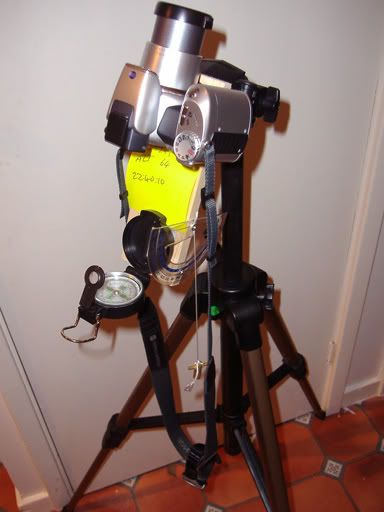
Anyway, I checked on Heavens Above for a good pass, no Iridiums, but the ISS was going to be a doozy, sailing right through the bowl of the big dipper. I gathered the time, Altitude and Azimuth bearings so that I could point the SatCatcher in the right place and setup in the garden. After a rough level with the inbuilt level on the tripod, I used the protractor and compass to align and fired a test shot. All looked good, so I had a look around with my bins. This was a total wash, as I was unable to find much of interest to see, bit of a shame really, but never mind. As the time approached I got ready. I could already see the ISS rising through the sky at an incredible rate and I had to try really hard not to fire the camera early thinking I was going to miss. At the predicted time, I triggered the shutter for a 30 second exposure. The results was spot on with the prediction and proves that the SatCatcher works perfectly.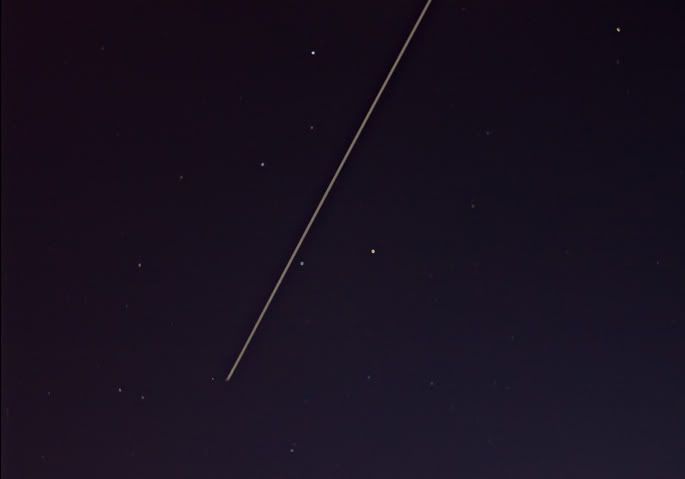
I'm really pleased it worked so well. There's a really bright flare forecast for Saturday night, I hope the skies are clear for it.
Saturday, 24 May 2008
Spotting the ISS
I glanced outside last night to check the cloud cover for testing the Inclinomter, and through a momentary clear spot, something caught my eye. Well actually, it more reached out and grabbed my eyeball. It was so bright and yet lasted far too long for an Iridium flare, and was travelling in the wrong direction, so I figured it had to be the ISS. I checked on HA this morning and it was indeed the ISS at mag -2.5. It was a shame that within 5 minutes the gap in the clouds had gone, -8 would have been really bright.
Friday, 23 May 2008
Home Brew Camera Inclinometer
After my success, well I got the flare in the centre of the frame even if there were too many clouds, I decided that to make life easier, and remove the guesswork, I could knock together an inclinometer that I could attach under the camera and to the tripod. After a bit of thinking, I decided on picking up a cheap plastic protractor from the local stationary store for £1.29 that I would mount to the side of a thin piece of wood and attach a plumbline to that. I then drilled out two holes by hand, holding the drill bit between my fingers and twizzling it, I figured using the drill would shatter the protractor. Then I drilled a suitable hole, to allow a 1/4" whitworth bolt through, in the thin piece of wood (about 10mm thick). Using some handy chipboard screws I had lying around, I attached the protractor to the side of the wood, 0° pointing downwards and 90° pointing to the rear. I took apart one of the Velbon tripod heads I have so that the rubber plate was free and used the 1/4" whitworth bolt from the camera piggyback point from my scope tube rings to push through the plate, up through the hole, through the rubber plate and protrude for insertion into the camera. Here's a shot of the inclinometer, nearly complete, in situ.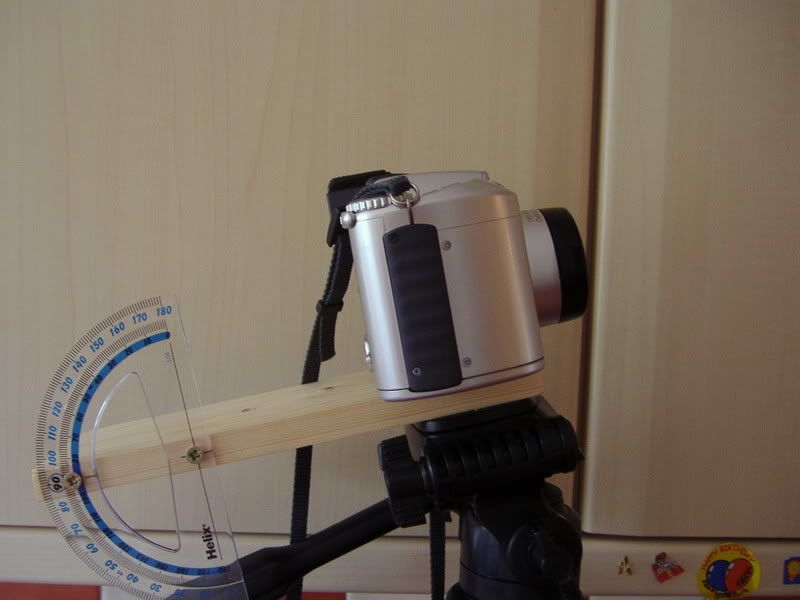
I have since added a piece of string, tied around the screw at the centre of the protractor and used a spare brass radiator bleed valve key I found in my toolbox as the weight. I've already thought of at least one improvement, by using a small ring on the screw thread with the string tied to that, the movement of the string rotating on the screw will be better. I've also been thinking if there's anyway of mounting another, adjustable, piece of wood with a level on, that I can also rest a compass on for that Azimuth bearing.
As you would expect, having completed this and eager to test it out, Heavens Above is predicting a superb and ideal target. An Iridium Flare at Mag -8 passing almost overhead, and the clouds have come in. Oh well.
A Mizar correction
I made a small mistake when I wrote the report the other night and referred to Mizar and Alcor as a double. This isn't the case, they are in fact just close together from our position. Thanks to Hal2000 for the correction.
I also forget to mention that I had a look around Cassiopeia with the bins. This was a total washout. With the bins I could just about make out the 5 main stars, forget anything else.
Last night, after a really rather nice day was awash in grey stuff (clouds) so I didn't get to see anything of the night sky, although I kept looking out just in case. Ah well. Back to normal again I see.
Wednesday, 21 May 2008
Cloud dodging
Well, after another evening of things to do, getting in the way of being outside. I thought I'd try my hand at a spot of catching an Iridium flare on chip. Thanks to Geppetto for the technique. Checking on Heavens Above, I worked out that Iridium 47 at 23:22:19 was the optimal one to see. I also wanted to check if I could see Saturn's rings in my bins.
So I started out at 2300 with the bins mounted on the tripod to steady them and had a look. To be honest, I would have to say that I couldn't be sure. Saturn wasn't a perfect spot, but neither could I say for certain that what I was looking at had so much as a tiny bump on the edges. Ah well, so after a quick change around, the camera now on the tripod, bins around my neck. I got setup for the flare attempt. Using a compass I aligned the camera by eye on the azimuth bearing, and guessed an approximate altitude bearing. I figured that leaving the camera unzoomed, the image would be wide enough that I had quite some leeway.
I then had 20 minutes to burn, so spent the time trying to spot objects through gaps in the clouds by a process of gap scanning. This entailed pointing the bins at a gap, and moving through what stars I could see till I found something interesting. After a few minutes, I found Mel111. I think this is probably my favourite cluster at the moment, now that M45 has sunk, and M44 is sinking in the murk over the town in the west, and the globs are playing peekabo behind the houses. I noticed then that the Dipper was mostly visible and had a look at the horse and rider. Given that this is a double star that can be seen naked eye, in bins it's really very easy. I had a look for the engagement ring around Polaris, but even finding Polaris was tricky. Then whilst I was scanning for a gap in the cloud, along came a satellite. I haven't been able to figure out what this one was as yet, it passed over in a roughly South to North track at about 2315. HA indicates it might have been the ISS based on the time, but I don't think the track fits. I'd just written that pass down and was scanning for another gap in the clouds, when along comes another satellite. This time I was able to ID it as Lacrosse 4.
I spent the next 5 minutes clock watching, and checking the camera bearing. At 232210 I triggered the camera, thankfully I had checked I'd removed the lens cap, otherwise it would have been a total disaster. Then glancing quickly up, I caught Iridium 47 exactly where I'd expected it to be. Hooray. Then when the camera clicked off, I checked the preview. Nothing, well, I say nothing, greyish lumps. Blast (Ha, yeah right!!) I thought. Grabbed all the gear, came inside and put it all away. Then I downloaded the raw file from the camera.
Well, after loading it into PS and doing the raw conversion on it, what do I find, but the flare is there, almost dead centre of the shot lurking in amongst the clouds. A little processing with levels, curves and noiseware resulted in this :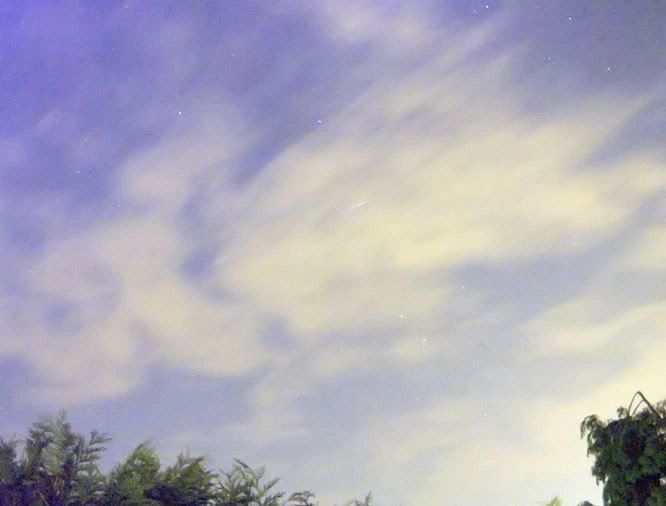
I'm really quite pleased with that, as odd as it sounds from looking at it. It's not a great picture, but the flare is there. I've also caught Saturn and Regulus down and right from the flare. Now, if only I can do this again when the skies are clear.
Tangerine Moon
Too many things to do last night, so even though it was clear, I never got out, even with the bins for a look around. However, through the window I spotted the moon, really low down in the sky at 11pm last night. Because it was so low the refraction of the light through the atmosphere was causing some really odd colour effects. I snapped a bunch of images, and here's the best one.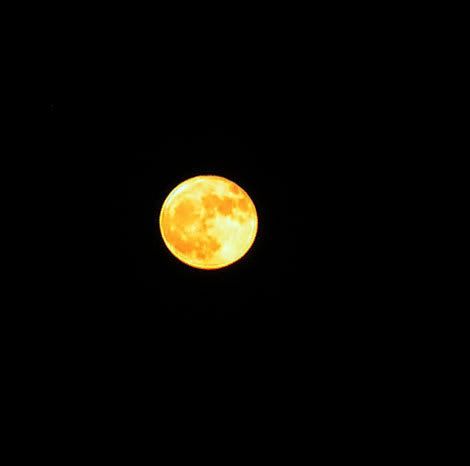
Hopefully, the sky might be clear, and I'll actually get some time to enjoy it this evening.
Tuesday, 20 May 2008
A Brief Bins View - 19th May
I really had no time at all to get out last night, which is somewhat irritating as it was the first proper clear night in at least a week. Ho hum. Anyway, I spent about 10 minutes outside with the Bresser 10x50. I started with looking at Saturn, I'd read on SGL that even with 10x50's you ought to be able to see the rings (as a tiny bulge), I suspect that to do so you have to mount the bins on a tripod, which I didn't do, but I couldn't say for certain that I did, even after using various nearby objects as a leaning post.
Then I had a quick look at the moon, considering it wasn't full moon last night, I was surprised by how low in the sky and to the south the moon is appearing, however, after my previous sessions, it was good to be able to put some names to the spots and holes I could see in the bins. Aristartchus stood out bright and clear on the western (hmm, wonder if that's right) left hand edge. Tycho and the patterns were also really clear.
As this was such a short session, I didn't spend long on the moon, and quickly turned to try and find Mel111 in Coma Bernices. It took a little while, as the last time I saw this was a couple
of months ago, and the sky has turned around quite a long way. Still, with a few minutes perseverance, I found it, and without reference to books, excellent.
I then had a quick look around Cassiopeia, but as she's so very low in the North, the glow from Gatwick spoils the view. Still I had a look for and found Kemble's cascade, a bit easier as it's higher in the sky, but it's also quite dim, so I didn't see all the stars in the cascade.
I'm glad I got out but it's a shame it was for such a short session. And today there's not a spot of blue in sight up above, that'll make a change then.
Thursday, 15 May 2008
Last go at the AVI's
I had a go at some post processing on the mosaic and close in shot of Theo. Using, Focus Magic, an Unsharp Mask and despeckle I ended up with :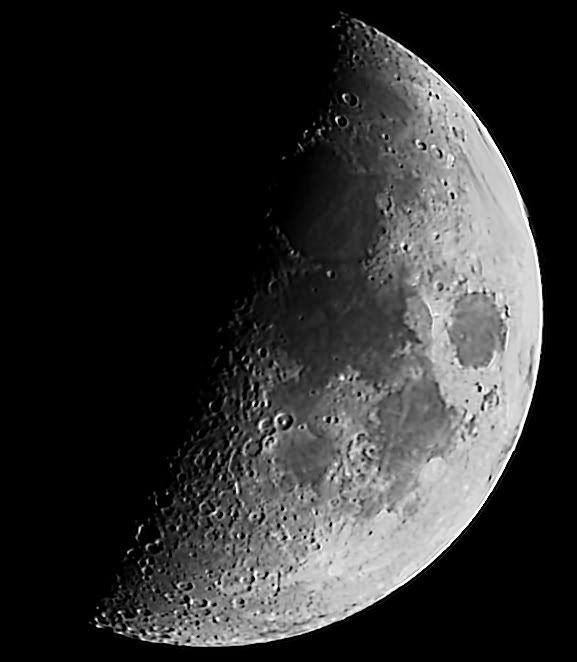
and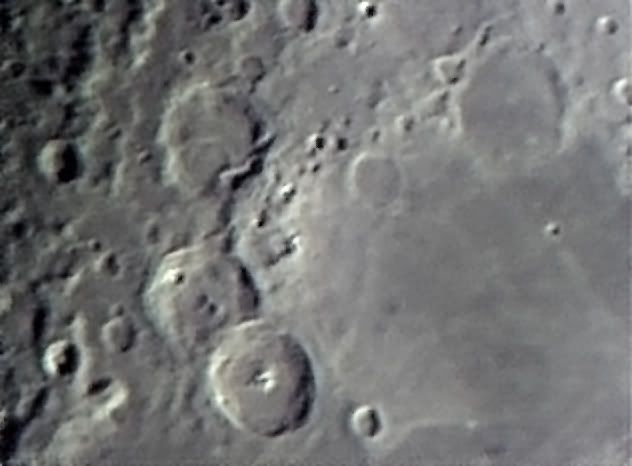
I think they are an improvement. I did attempt to run various other things, Contrast Masking, various filters etc, but they didn't improve them any further to my eyes. It looks like the Moon Mosaic has been overexposed on the limb, but as I was concentrating on getting the terminator correct, this isn't really a big surprise. Next attempt make sure the limb and bright areas are properly exposed, not burnt out, the darker areas can be lifted to bring out information, but if it's not there in the first place.
Tuesday, 13 May 2008
Lunar Mozaic - Revisited
I had another go at processing this last night. It was cloudy. Anyway, after some hints from Astro Chat I played around with the settings in Registax and this time, it decided that all the frames in both AVI's were within the 75% quality that it selected as default. I let it run with that, and after a long time processing and some fiddling with wavelets, using the same on both, I had a pair of images. I did a little cropping to remove the stacking lines around the bottom, I'm guessing they came from the seeing wobble in the images. I put them together in imerge. Having done that, back to PS for a sharpen and despeckle and flip (I forgot about the image inversion on my first go). Here's the results.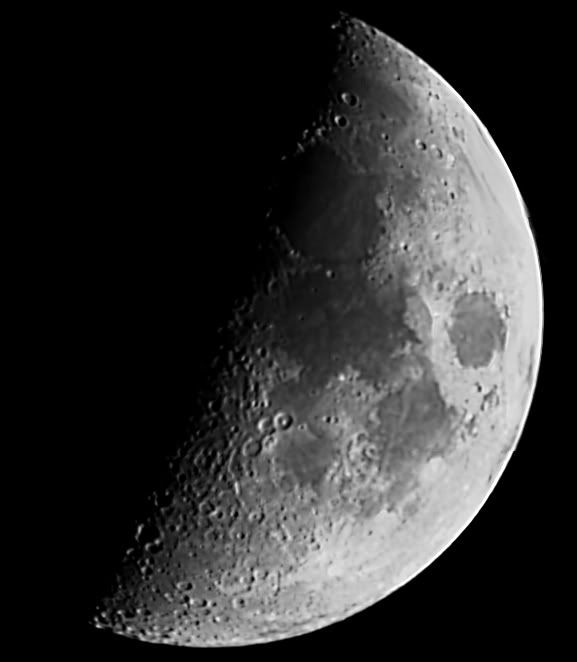
I think it's a little better than the first go. I also figured out what doesn't quite look right with this image. The limb of the moon is not in focus. I'd been concentrating so hard on the terminator area, I hadn't even noticed this. I guess with my short tube scope, the depth of field is insufficient to cater for the ballness of the moon. This means that on my next go, I'm going to have to adjust focus, that's easier said than done at the moment, and capture another set of avi's to allow for the different focus points, then mozaic those. Ah well, always next time, but another useful tip added to my notes of things to do right next time. I really ought to write them up somewhere.
Monday, 12 May 2008
Experimental testing
I carried out one little experiment last night. I used an Antares 5x barlow with the webcam on my little f5 80mm Achro. Consider the seeing was really rather rubbish, and I seriously overpowered my scope, up to over 300x mag (Max is 160x). I hadn't originally intended stacking this, but figured why not. I used a single alignment point in Registax, and just sort of took the defaults until wavelets which I just moved sliders around until it started to look good. To get anything at all on screen, I'd had to shove the gain of the webcam up to pretty much maximum, as the x5 barlow robs a lot of light. Still, after a quick despeckle in PS, this is the result.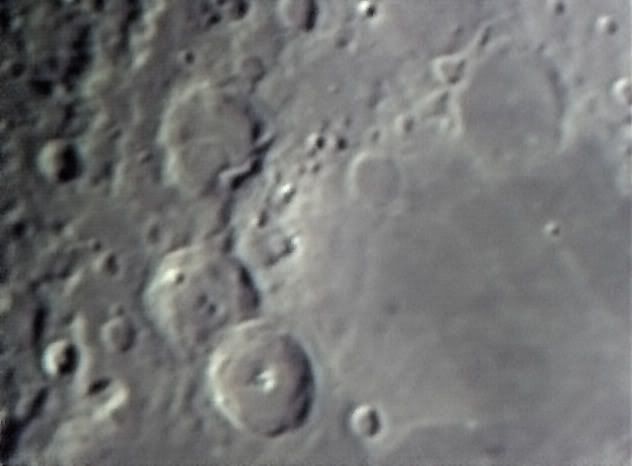
I'm really rather pleased with that, and I'm looking forward to a clear night with better seeing to be able to give this a proper work out. Of course the current R&P focuser is a total pain at this sort of level, because it just doesn't provide enough fine control, and with the play in it, shifts the image all over the place. I had to use the motors on the mount in the end to get the craters back in the frame after I'd stumbled on focus.
Second go at webcam on the moon
I had to pop out early evening and drop some things around to a friend. Whilst there, I had a quick go with their telescope. It's a very small scope, not sure where it came from. It appears to be a 50mm Frac with an FL of about 350mm. Getting any magnification is just not going to happen, with the supplied 9mm ep, it's getting about 39x, so it's probably pretty good for the brighter large clusters, M44 and M45 spring to mind, but at about 9pm last night, the moon was the only real target. oh, it's got a 0.96 (??) focuser and ep's, so just using some ordinary plossls aren't going to work. I had a look t the moon, and the view was pretty good. I couldn't detect any CA, but that may be due to lack of magnification, or going blind looking at the bright moon. The entire moon fitted in the FOV, but having said that you could make out a fair amount of surface detail, Theophilus, Cyrillus and Catharina for example were obvious and clear.
I had other things to do, so I left them to it and headed off.
After way too many things needing to be done, it was quite late by the time I got my gear out and the Moon was heading lower towards the west. I did a quick setup, level and align on the moon, dropped in the webcam with both barlows and had a little play. Having taken a look, I ended up just going for the webcam without the barlows and took 2 avi's of nearly 3000 frames each, one of the top half, the other the bottom, or should that be the other way around... hmm.
A small note, whilst the much that has been in the sky for the previous few nights wasn't there, the seeing was pretty poor. As I watched on the lappie, the moon seemed to swim and dance before my eyes.
Anyway, after capturing the AVI's I went to work on processing them. After running them both through registax, for some reason the first one stacked over 2000 frames, and the second one only 80, but never mind. I applied the same wavelets set, reminder to self, if doing another mosaic, save the wavelets setting after the first process. Luckily, I'd followed some advice from someone on Astrochat and used the Imageinfo button, so at least I had the details somewhere. Anyway, here's the resulting images :
Stack 1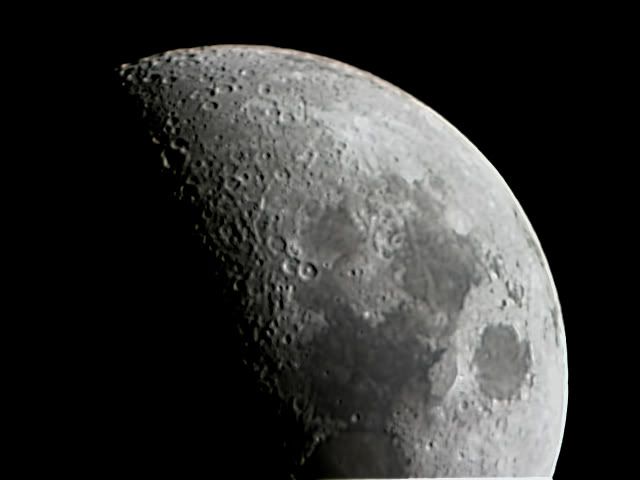
Stack 2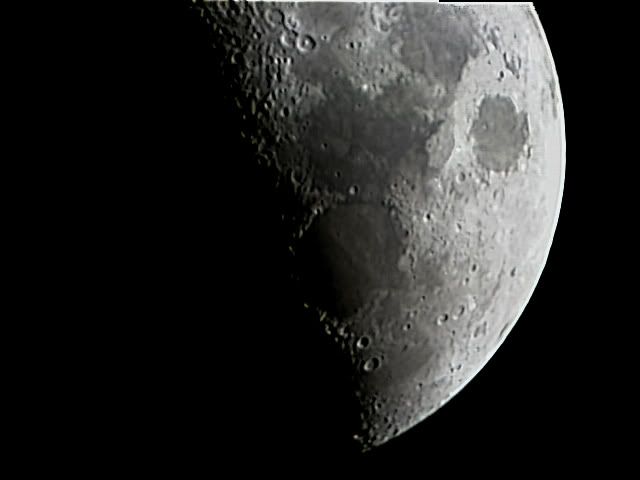
Having done these two, I made a small crop to remove the odd lines in the middle, then I used imerge to combine them and create a mosaic of the moon.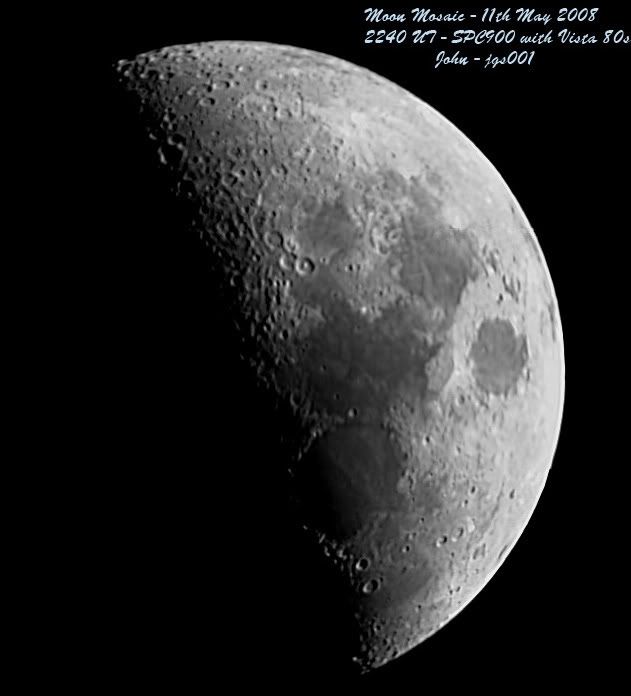
I didn't get to do any visual observing, which I did miss, but given the time scales, and the capturing only took 20 minutes I'm pleased I did setup and do this. It was also rather pleasant to be sat outside in a jumper without freezing to death at nearly midnight.
Friday, 9 May 2008
Sharing the EP
The sky started off cloudy as the evening started to draw in, but I was pleasantly surprised to see these disappearing around 8pm. I grabbed the scope and got setup for a little daylight viewing, and to share the ep so the visitors we had could all take a look. Following the usual, level and power up, I aligned on the moon, and setup with the 5mm Hyperion and x2 barlow. Most of the people here were quite impressed and I even got a couple of oh wow's, all except the OH who said, "ohhh, it's the moon, I can see that on google earth". Ah well, never mind, it's a lonely life looking into space ti misquote something or other.
Once everyone had taken a look, I decided to have quick play with my barlows just to see what I could see. I started off replacing the 2x barlow, with the 5x barlow. This gives me something like 400x, which is about 2.5x more than my little scope is probably capable of. However, I could see some detail, but focusing was a total mare. I then messed about with various ep/barlow combinations, and settled on trying out the 17mm Hyperion, with both the 5x and 2x barlow in line. This provides a magnification of about 240x. Still a bit OTT, but I didn't think it was too unusable, but the image was very dark. I look around the scope, and the mist and murk was making it's way back in again. I had been hoping that the clear air would stay so I could try out the webcam in the 5x barlow, although as I'm still on the stock R&P focuser, I suspect it would have been problematic. So anyway, the moon, naked eye, was looking like it had been dipped in flower and given a good shake and the bits were floating around it, so I packed up.
Ah well, so another night with very little to show for it, although it was good showing everyone and providing some surprises. I didn't even get the time to note down any craters, although from memory, when I was setting the scope up, I could see Atlas and Hercules and the craters along that line, but I can't remember the others off the top of my head.
Reprocessing the Moon
I had a go at reprocessing last nights Lunar AVI. I managed to convince Registax to use 1900 of 2000 frames, using a multipoint stack. Some tweaks of wavelets, still not sure what these all do, but I move them about a little till it looks better. Then some processing in PS to make the dark darker etc. And this came out :
I'm quite pleased with this. The dark eyes of Mare Crisium are showing really nicely (Picard and Peirce) and even the ripples in Mare Fecunditatis. Must remember to cut the gain down somewhat as I've also managed to burn out the outer edge of the limb, but it was good to get done and in the can.
Thursday, 8 May 2008
Some time on the moon
Well, the sky is still murky and cloudy, and even the moon was looking poor through the bins. But I decided I'd dig out the scope and setup as this would give me some practice with the webcam. I setup, powered up, aligned as usual. Dropped in the webcam with the usual tubing, and odd, I couldn't get focus. What's going on here I wondered ? After much playing and fiddling with tubes, I found that what works for Saturn, doesn't work for the moon and instead of the prism diagonal, used the normal mirror diagonal. Ah well, something to remember for the future. I took 2 sets of 2000 frames and 1 set of 1000 frames and some dark frames. I had some help from my cat providing KISS (Kat Induced Seeing Shakes) which really didn't help much.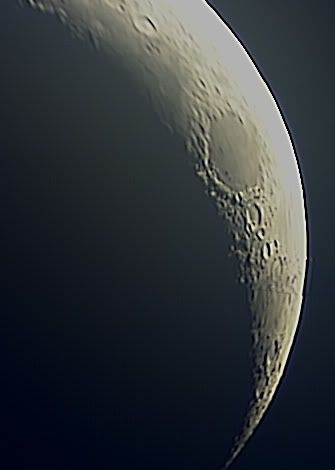
After doing the avi's, I changed the webcam to the 5mm Hyperion for some visual observing. I tried using the 2x Barlow, but the image became too dark because of the misty cloud covering the moon. So I settled for just the Hyperion, giving my 80x. I started at Mare Crisium, a nice easy to find reference point, hey you can see it in bins. From there I took the normal route for this point in the Lunar phase, past Cleomedes and Buckhardt to Geminus. Nearby Messala and on around the limb to Endymion. Then back to Mare Crisium and set off in the other direction. Past Apollonius to Mare Fecunditatis, on into Langrenus. Nearby I landed in, Bilharz, Atwood and Naonobu. From there to Vendalinus. Then after I produced one of my patented quick, yet poor sketch for identifying craters, using Petavius, Snellius, Stevinus and Furneris as referent points, I also got Wrottsely, Hase, Adams, Furneris C and Fraunhofer. That was it for tonight, and I think I was lucky to get that much. The view was getting worse as I was looking, and has now disappeared entirely into the clouds, all except a faint tantalising glow in the clouds itself. Ah well. Maybe as the moon grows fuller, the clouds will stay away more. I can but hope.
I snapped a photo of the moon to see if I could show the mistiness.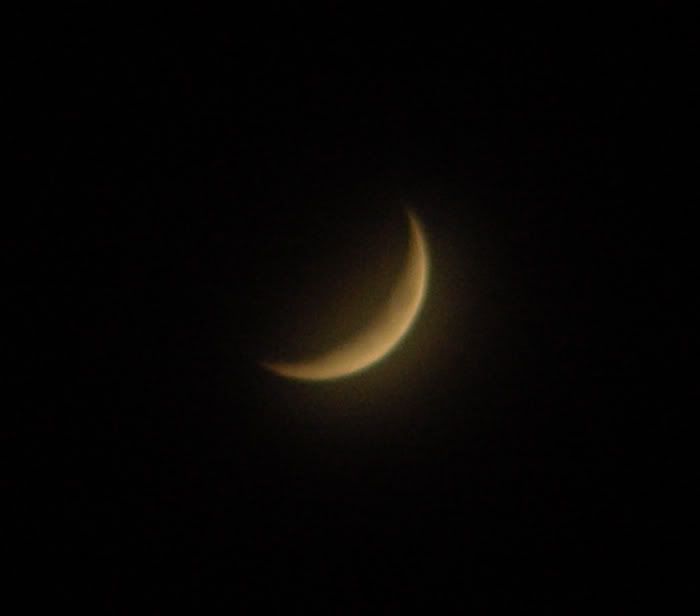
It was interesting to note, that this entire session was carried out in normal day clothes and not wrapped in piles of clothes, coats, hats and gloves. Actually rather pleasant from a temperature point of view, shame about the view really.
Wednesday, 7 May 2008
Earthshine and a quick Bino Scan
I was unable to make use of the clear skies last night, to be honest, it also looked like very poor seeing. I did glance out tonight and see a thin crescent moon, and after quite a few shots handheld, I setup on the tripod for a few to see if I could capture a series and stack them. This didn't work, but the first one was surprisingly good. This was captured in RAW at ISO100 with a 1 second exposure. The star above the moon is Alnath or Beta Tauri.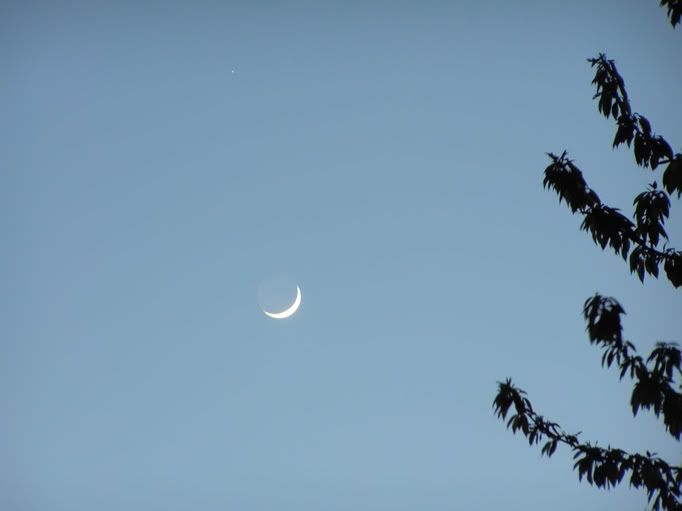
Some time later, I got the Bresser bins out and had a look around. I think there's some high thin stuff up there somewhere, the views were quite disappointing. After some effort I had a look at M44 and it was not good. I was able to see Mizar and Alcor, but unable to see the engagement ring around Polaris. Whilst I was scanning, I spotted a moving dot. Aha thought I, must be a satellite. I tracked it in the bins for a while, then started scanning again, and what should I find almost immediately, but another one. Cool. By my reckoning, and a quick glance at Heavens Above, I think they were the Helios 1a rocket and Cosmos 1220.
As all the views seemed so poor, I gave up and came back in. The stars are not going anywhere, so one of these days I'll get a good night.
Saturday, 3 May 2008
Another go at the ringed one
Another fine night last night. I got out about 9:45 pm, and setup as usual. Leveled, powered up, planetary align on Saturn. Then swapped the visual pipes for the webcam pipes. Hmm, couldn't find saturn on screen. Swapped the cam for the 5mm Ortho, and re-centered. Swapped to the webcam again, and this time could see Saturn. So far so good. Added the 2x barlow. Still there. As I'd received the 5x Antares barlow during the day, I thought I'd try with that. I swapped the 2x out and again couldn't find Saturn on screen. What's going on here ? I went back to the 2x barlow, still no sign, back to the Ortho, re-centered again. Back to the 2x Barlow and webcam and tried to focus. This is getting silly. Every time I tough the focuser the image jumps off the screen. I'm going to have to do something about this.
Anyway, I finally managed to get something vaguely approaching focus and, using WXAstroCapture, shot off a short AVI of some 900 frames. Then I popped the lens cap on the scope and grabbed 200 frames of darks. All ready for later processing. This has taken an hour to get. After a process with Wavelets and a minor adjust in PS.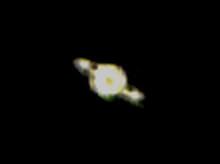
I then swapped back for visual use, dropped in the 5x barlow and the 5mm Hyperion and spent some time staring at Saturn. This is the first time I've seen the planet look like a sphere rather than a flat disk. And in the odd moments of sharper focus, I was able to clearly make out the rings. The problem is that this is seriously over powering my little scope, but I want to see what happens with the webcam, if I can ever get focus smoothly. I took this all out and swapped to the 17mm Hyperion.
After a visit to Stellarium to have a look at what interesting objects might be around. Having made a short list, I used the Goto to slew to the first target NGC2331 and was looking at a blank patch of sky. That's odd, this is supposed to be an open cluster. Hmm. I used the goto to slew to Mars. Hmm, way out. Ok, I don't know what has happened there, but I powered down, powered up, a quick planetary align on Mars, and try again. Still no good. Huh ?? I reset again, and did a full sky align. Still the goto was out by quite some distance. Ah well, enough of this. I can find the Beehive easily enough, so I used the manual controls to slew around to M44 and spent some time looking at this lovely cluster and tried to sketch it.
I've come to the conclusion I need a new focuser, what I have works ok for visual use, but for imaging, it's just no good. Ah well.
Friday, 2 May 2008
Saturn has too many rings ??
Finally after a week that seems to have taken a month to pass, I had a clear night. After I'd done all I had to indoors, I got out and setup about 10pm. Leveled, powered up and used Solar System Align with the 5mm Ortho on Saturn. Then I swapped the optics out of the back end of the scope, and replaced it with the Prism Diagonal, 2x Barlow and the SPC900, wired up to the laptop. I got focus, although it all looked a bit soft. I thought I'd try a little experiment and inserted the 30mm extension tube between the barlow and the webcam. This made the image bigger. Excellent.
I took 2 AVI's of about 2000 frames each. One using k3ccdtools, the other using wxastrocapture. After the second one I capped the scope and took a 200 frame AVI of darks. Then using registax, stacked the first avi, then converted the dark avi to a single file, need to remember the correct formats that registax can load for future, and used the darks to subtract from the second avi. I'm not quite sure what happened, but I guess either the focus was a little out or the seeing was poor, but I've got some ghosting in the ring system, and it looks like there are 2 rings around the planet. I also don't know why the second one came out quite so yellow.
K3CCDTools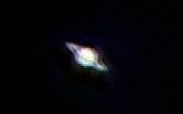
WXAstroCapture - darks
The above took nearly an hour. I then converted back to optical use, mirror diagonal, extension tube etc, dropped in the 24mm Hyperion and used the Goto to hop round to have a look at the Beehive M44. A lovely looking cluster, it is, and with the 24mm Hyperion, I can see the two stars of Cancer either side. Whilst I was looking a very faint dot passed through the field of view. It was slow enough that it wasn't a meteor, so I think it was probably a Satellite. The best I can find on Heavens Above is Envisat, but I'm not so sure, as the Envisat pass was supposed to be quite bright, and whatever this was, was much dimmer than the stars in the hive.
I then popped inside and grabbed my Planisphere for a check around the constellations. I have finally managed to work out where Virgo is, it's clearing the roofline of the house now. For the same reason, I found, Hercules, Lyra, and Serpens Caput. Corona Borealis was quite easy to see, once I'd got my head oriented. And looking to the North, through the murk around Gatwick airport, I was able to see some of the stars of Cygnus.
I then used the Goto to have a look at a couple of Globular Clusters, M3 and M13. My scope is a little low powered to be able to do these clusters justice, but by using the 5mm Hyperion, I was able to bring the cluster out far more, but couldn't make out any of the stars.
At this point, some clouds were moving in and I was getting cold, so I headed indoors. I'm not sure what I'm going to be able to do with the webcam images. I think I'm going to have to wait for the moon to come around before trying webcam imaging again.






